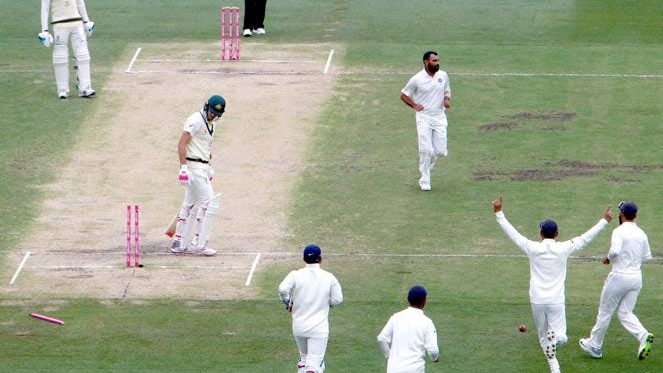The follow-on in Test Cricket allows a team to force their opponents to bat again immediately after their first innings, provided they have a substantial lead. For instance, if Team A scores 469 runs, Team B must score at least 270 runs to avoid the follow-on.
Test Cricket and the Follow-on Rule

Test cricket is the longest and most traditional format of the sport, requiring immense stamina, mental resilience, and strategy. The first Test match, played in 1877 between England and Australia at the Melbourne Cricket Ground, marked the beginning of an enduring rivalry. Australia won that inaugural match by 45 runs, setting the stage for a competitive legacy.
One of the most strategic rules in Test cricket is the follow-on, which can significantly impact the outcome of a match. This rule is essential for teams aiming to dominate their opponents and potentially end the game earlier.
Also Read:- Top 5 Lowest Scores by CSK in IPL History
What is the Follow-on in Test Cricket?

In Test matches, the follow-on rule allows the team that bats first to enforce the opposition to bat again if they hold a significant lead after both teams’ first innings. To enforce the follow-on, the team batting first must lead by 200 or more runs. For example, if Team A scores 450 in their first innings and Team B replies with only 200, Team A can enforce the follow-on. This forces Team B to bat again without a break, which puts immense pressure on them to avoid being bowled out twice.
The decision to enforce the follow-on lies with the captain of the team that batted first. Teams often choose this strategy to push for a quicker result, particularly in scenarios where weather or time constraints may prevent a win. By dismissing the opposition twice, the team can eliminate the risk of a draw.
Follow-on Rules in Different Formats

The follow-on rule applies in long-format cricket, including Tests and domestic First-Class matches. In these formats, both teams typically bat twice, and a match can only be won after at least three innings. The rules for enforcing the follow-on vary depending on the match length. According to Law 14 of the Laws of Cricket:
- In five-day Test matches, a lead of 200 runs or more is required to enforce the follow-on.
- In four-day First-Class matches, such as the Ranji Trophy, a 150-run lead is sufficient.
- In two-day matches, a lead of 100 runs is enough.
- For one-day matches, a lead of just 75 runs is required to enforce the follow-on.
If the first day of a multi-day match is affected by rain or other interruptions, the required lead may be adjusted according to Law 14.1.3.
Notable Matches Where Teams Lost After Enforcing the Follow-on

While enforcing the follow-on can be a strategic advantage, there have been instances where teams have lost despite holding a massive first-innings lead. In such cases, the team batting last must surpass the opposition’s total from the fourth innings without being bowled out. However, if the bowling side dismisses all 10 batsmen before the target is reached, they win. The match ends in a draw if the batting side fails to chase down the target but still has wickets remaining when time runs out.
There have been four occasions in Test cricket where teams have enforced the follow-on but still lost:
- Australia vs. England, 1894
Australia, leading by 261 runs in the first innings, enforced the follow-on at the Sydney Cricket Ground but lost by 10 runs. - Australia vs. England, 1981
At Headingley, Australia led by 227 runs but suffered an 18-run defeat against England after enforcing the follow-on. - India vs. Australia, 2001
Despite holding a first-innings lead of 274 runs at Eden Gardens, Australia lost to India after enforcing the follow-on. - England vs. New Zealand, 2023
At Basin Reserve, England led by 226 runs in the first innings but lost to New Zealand after enforcing the follow-on.
Understanding the Term “Trail” in Test Cricket

In Test cricket, the term “trail” refers to the number of runs a team is behind the opposition’s score in the first innings. For instance, if Team A scores 300 runs and Team B scores 250, Team B is said to be trailing by 50 runs.
FAQs
- What is the follow-on score for 578 runs?
If a team scores 578 runs in their first innings, their opponent must score at least 378 runs to avoid the follow-on (578 – 200 = 378). - How many runs are required to avoid the follow-on if the score is 210?
To avoid the follow-on, the team must score 410 runs (210 + 200). - How many runs are needed to avoid the follow-on at 480?
The team would need to score 280 runs (480 – 200). - How many runs are needed to avoid the follow-on at 110?
The team would need to score 310 runs (110 + 200). - What is the follow-on rule for a score of 469?
If a team scores 469 runs in their first innings, the follow-on score for their opponent is 270 runs (469 – 200).
For more insights, features, and the latest cricket news, stay connected with e2-bet.in
Also Read:- What is Slow Over Rate in IPL
